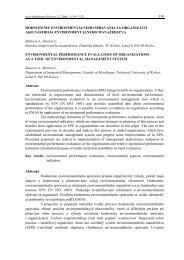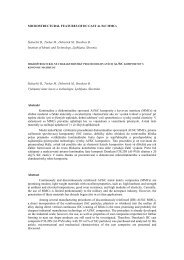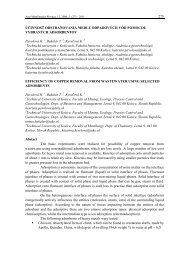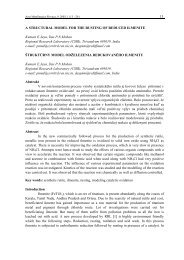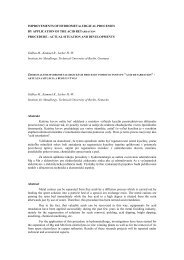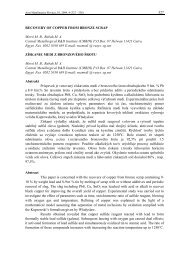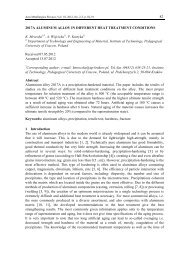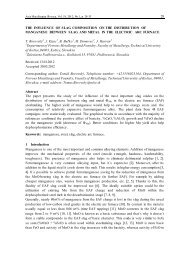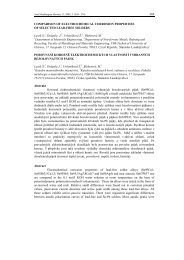199 mathematical modeling of mold-filling and solidification - Acta ...
199 mathematical modeling of mold-filling and solidification - Acta ...
199 mathematical modeling of mold-filling and solidification - Acta ...
You also want an ePaper? Increase the reach of your titles
YUMPU automatically turns print PDFs into web optimized ePapers that Google loves.
<strong>Acta</strong> Metallurgica Slovaca, 15, 2009, 3 (<strong>199</strong> - 207) 206<br />
where T l <strong>and</strong> T s are the liquidus <strong>and</strong> the solidus temperatures (K), respectively. Another widely<br />
used expression is the Scheil equation, which assumes uniform solute concentration in the liquid<br />
but no diffusion in the solid [23]:<br />
−1/1−k ⎛ T<br />
o<br />
m − T ⎞<br />
f s = 1 − ⎜ ⎟<br />
Tm<br />
T<br />
⎝ − l ⎠<br />
(12)<br />
where T m is the melting point <strong>of</strong> the solvent metal (K),<strong>and</strong> k o is the equilibrium partition<br />
coefficient <strong>of</strong> the alloy.<br />
Eq. (10) defines the heat flux [3] which is released during liquid cooling <strong>and</strong><br />
<strong>solidification</strong>. In classical models, the heat generated after <strong>solidification</strong> is assumed to be zero,<br />
i.e., for T< T s , Q & = 0. However, experimental investigations showed that lattice defects <strong>and</strong><br />
vacancies are condensed in the already solidified part <strong>of</strong> the crystal <strong>and</strong> the enthalpy <strong>of</strong> the solid<br />
increases <strong>and</strong> thus the latent heat will decrease. Based on this fact, another way to represent the<br />
change <strong>of</strong> the solid fraction during <strong>solidification</strong> can be written as [3]:<br />
2<br />
⎡ π ( T − T ) ⎤<br />
( T − T ) + ( Ts<br />
− T )(1 − cos<br />
l<br />
l<br />
l ⎢ ⎥<br />
π<br />
⎣ 2( Ts<br />
− Tl<br />
)<br />
f =<br />
⎦<br />
s<br />
( Tl<br />
− Ts<br />
)(( 1−<br />
2 / π )<br />
(13)<br />
Combining Eqs. (7), (9) <strong>and</strong> (10), the new unsteady state heat conduction equation<br />
can be expressed in the form [4; 23]:<br />
∂ ( ρ c´<br />
T )<br />
= ∇.( k∇<br />
T)<br />
∂ t<br />
(14)<br />
At the range <strong>of</strong> temperatures where <strong>solidification</strong> occurs for binary metallic alloys, the<br />
physical properties will be evaluated taking into account the amount <strong>of</strong> liquid <strong>and</strong> solid that<br />
coexists in equilibrium at each temperature, as shown by Eqs. (9), (10) <strong>and</strong> (14).<br />
3. Conclusions<br />
A comprehensive theoretical basis regarding equations <strong>of</strong> fluid mechanics <strong>and</strong> heat<br />
flow has been shown. Like other CFD problems, the momentum equation, the continuity<br />
equation, <strong>and</strong> the energy equation are the partial differential equations that are essential in the<br />
numerical analysis <strong>of</strong> the casting process. The moving boundary liquid metal/air is modeled<br />
using the VOF method to trace the free surface in <strong>mold</strong> <strong>filling</strong> processes. The latent heat release<br />
during the unsteady <strong>solidification</strong> phenomenon is taken into account as a source term in the<br />
energy equation. The implementation <strong>of</strong> such equations is aimed to furnish important<br />
information such as <strong>filling</strong> dynamics <strong>and</strong> the thermal field along the casting process.<br />
Acknowledgements<br />
The authors acknowledge financial support provided by CNPq (The Brazilian<br />
Research Council), FAPESP (The Scientific Research Foundation <strong>of</strong> the State <strong>of</strong> São Paulo,<br />
Brazil) <strong>and</strong> CAPES - Coordenação de Aperfeiçoamento de Pessoal de Nível Superior.



